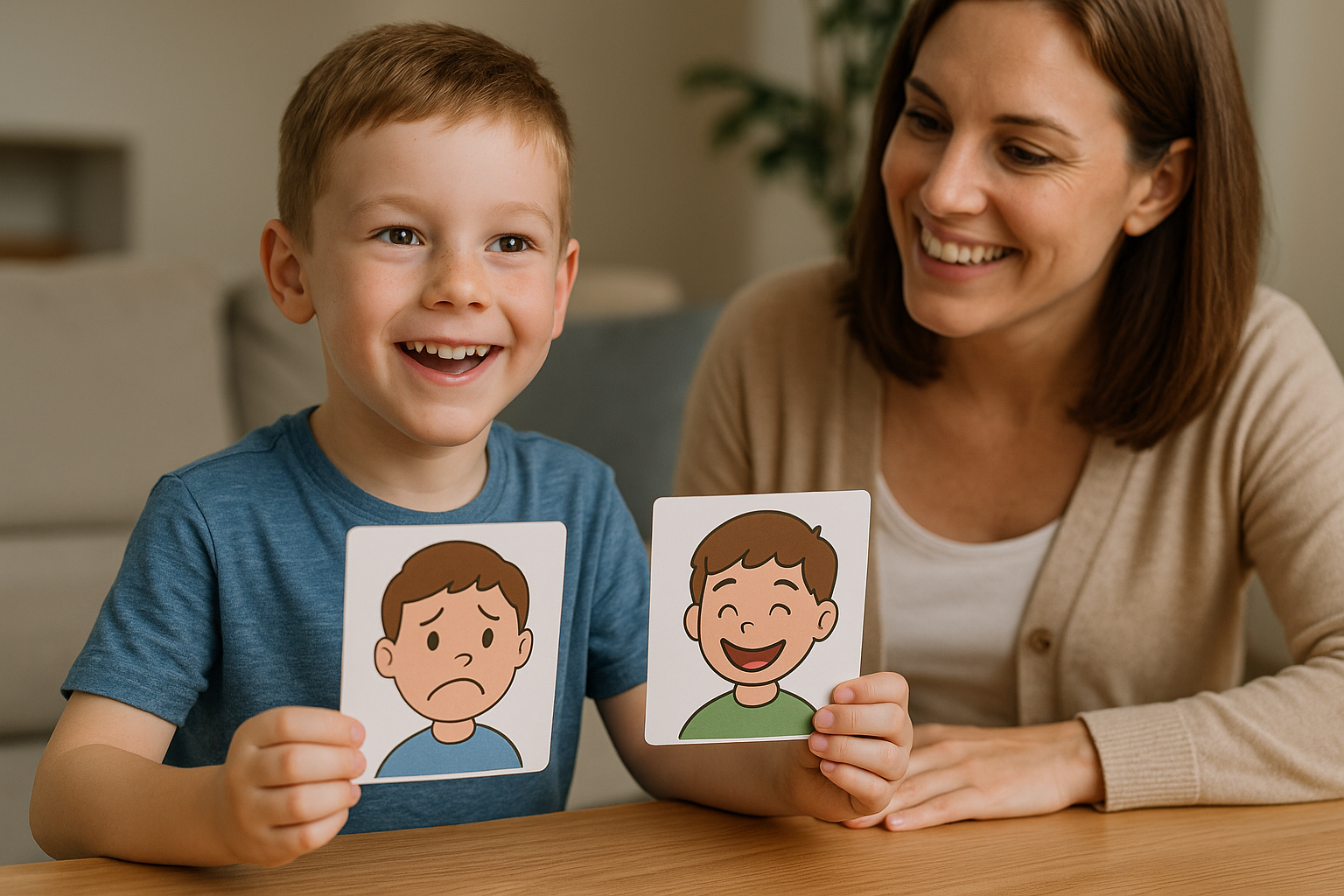
Why Emotional Expression Matters
Emotions are at the heart of human connection. From joy and excitement to frustration and sadness, expressing feelings helps us build relationships, manage challenges, and communicate needs. For children on the autism spectrum, however, identifying and sharing emotions can be complex.
Some children may:
- Struggle to recognize their own feelings
- Have difficulty labeling emotions in themselves or others
- Express emotions in ways that others misunderstand (like crying instead of saying “I’m sad”)
- Feel overwhelmed by strong emotions and struggle with self-regulation
Applied Behavior Analysis (ABA) provides a supportive framework to help children build emotional awareness step by step. By teaching recognition, labeling, and appropriate expression, ABA helps children gain the tools to manage their emotions and strengthen their relationships.
How ABA Supports Emotional Development
1. Teaching Emotion Recognition
ABA uses visual supports, games, and role-play to help children recognize emotions in themselves and others. Examples include:
- Emotion cards: Pictures of faces showing happiness, sadness, anger, or surprise
- Mirror play: Practicing facial expressions together
- Storytelling: Identifying emotions in characters from books or videos
By practicing recognition, children learn that each emotion has patterns they can understand.
2. Labeling Emotions
Once recognition is in place, ABA helps children label emotions accurately. Therapists may model phrases like:
- “I feel happy.”
- “I feel mad.”
- “I feel scared.”
Reinforcement is used to celebrate correct labeling, making it more likely children will use emotional language in daily life.
3. Building Coping Strategies
Recognizing emotions is only the first step—children also need tools to manage them. ABA introduces coping strategies tailored to the child’s needs, such as:
- Deep breathing or counting to calm anger
- Asking for a break when overwhelmed
- Using a calm corner with sensory supports
- Expressing needs verbally (“I need help”) instead of through meltdowns
4. Practicing Emotional Expression in Safe Settings
Role-playing and structured practice give children opportunities to try out new skills. For example, pretending a toy is sad and modeling how to comfort it helps children learn empathy and connection.
5. Generalizing Skills to Real Life
ABA ensures emotional skills transfer to daily life—at school, during playdates, and in family routines. Parents and caregivers are included in the process so they can reinforce progress outside of sessions.
Real-Life Example: Learning to Share Feelings
Olivia, a 10-year-old, often became frustrated at school but didn’t have the words to explain. Instead, she would cry or leave the classroom suddenly.
Her ABA therapist introduced emotion cards and role-play games. Olivia practiced pointing to “frustrated” when work felt difficult. Over time, she began using the phrase, “I feel frustrated. I need help.”
With support and reinforcement, Olivia’s meltdowns decreased, and her teachers noted she participated more confidently in class. Her parents shared, “She’s learning to tell us what’s wrong, and that has changed everything at home too.”
Parent Tips for Supporting Emotional Expression at Home
1. Model Emotions Out Loud
Say things like, “I feel excited because we’re going to the park,” to show how feelings and language connect.
2. Use Visual Aids
Create a simple feelings chart with happy, sad, mad, and calm faces. Encourage your child to point to how they feel.
3. Practice During Play
Use dolls, action figures, or stuffed animals to act out emotions and talk about what characters feel.
4. Reinforce Emotional Language
Celebrate when your child expresses emotions in words or visuals, even if imperfectly.
5. Keep It Positive
Emphasize that all feelings are valid, and the goal is learning healthy ways to express them.
Why Emotional Skills Matter Beyond Childhood
The ability to recognize and share emotions shapes success in every stage of life.
- At school: Children who manage emotions participate more confidently in group work and learning.
- At home: Families experience smoother routines and stronger communication.
- In friendships: Emotional awareness strengthens social bonds and conflict resolution.
- For adulthood: Emotional regulation prepares children for workplace challenges, relationships, and independent living.
By building these skills early, ABA provides a foundation for lifelong well-being.
Long-Term Benefits for Families
Families often describe emotional expression training as transformative. Children become less frustrated, parents feel more connected, and relationships thrive. Instead of confusion or conflict, families experience greater empathy and understanding.
ABA doesn’t just teach children to “name feelings”—it empowers them to share emotions in ways that strengthen every relationship they have.
FAQ
Q1: Can nonverbal children learn to express emotions?
Yes. Visual supports, gestures, and communication devices can be used to identify and share feelings effectively.
Q2: How long does it take to see progress?
Progress varies, but consistent reinforcement often leads to noticeable changes in weeks to months.
Q3: What if my child only expresses negative emotions?
ABA balances by teaching recognition of positive feelings too, reinforcing a full emotional vocabulary.
Q4: Will emotional expression skills carry into school?
Yes. Teachers often notice improvements in participation, focus, and peer interactions.
Q5: Can ABA help with emotional outbursts?
Yes. By teaching recognition and coping tools, ABA reduces frustration and helps children manage big feelings more calmly.
